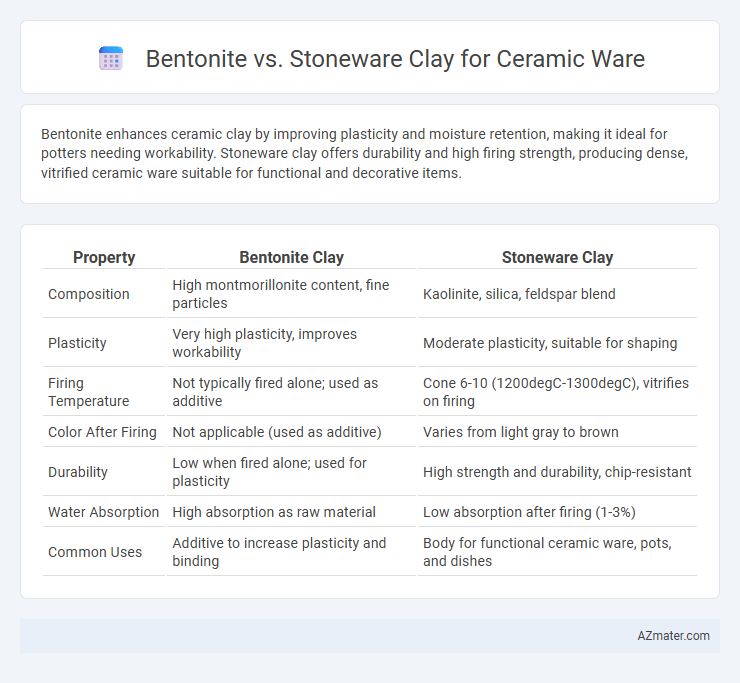Bentonite enhances ceramic clay by improving plasticity and moisture retention, making it ideal for potters needing workability. Stoneware clay offers durability and high firing strength, producing dense, vitrified ceramic ware suitable for functional and decorative items.
Table of Comparison
| Property | Bentonite Clay | Stoneware Clay |
|---|---|---|
| Composition | High montmorillonite content, fine particles | Kaolinite, silica, feldspar blend |
| Plasticity | Very high plasticity, improves workability | Moderate plasticity, suitable for shaping |
| Firing Temperature | Not typically fired alone; used as additive | Cone 6-10 (1200degC-1300degC), vitrifies on firing |
| Color After Firing | Not applicable (used as additive) | Varies from light gray to brown |
| Durability | Low when fired alone; used for plasticity | High strength and durability, chip-resistant |
| Water Absorption | High absorption as raw material | Low absorption after firing (1-3%) |
| Common Uses | Additive to increase plasticity and binding | Body for functional ceramic ware, pots, and dishes |
Introduction to Ceramic Clay Types
Bentonite is a highly plastic, fine-grained clay primarily used in slip casting and as a binder in ceramic bodies, valued for its swelling properties and strong particle binding. Stoneware clay is a dense, mid-fire clay known for its durability, vitrification, and natural toughness, commonly used for functional pottery such as dinnerware and cookware. Understanding the distinct properties of Bentonite and Stoneware clay helps potters select the appropriate material for specific ceramic ware applications based on workability and firing characteristics.
What is Bentonite Clay?
Bentonite clay is a natural, highly absorbent clay composed mainly of montmorillonite, often used in ceramic ware to improve plasticity and workability. Unlike stoneware clay, bentonite enhances the bonding properties of clay bodies, making them easier to shape and less prone to cracking during drying. Its fine particle size and ability to retain water make bentonite a valuable additive for achieving smooth, durable ceramic pieces.
What is Stoneware Clay?
Stoneware clay is a durable, non-porous ceramic material composed primarily of kaolinite, ball clay, and feldspar, known for its ability to withstand high firing temperatures between 1,200degC and 1,300degC. It vitrifies during firing, resulting in a dense, water-resistant body ideal for functional pottery such as dinnerware and cookware. Unlike bentonite, which is mainly used as a plasticizer to improve clay workability, stoneware clay serves as a primary material providing structural strength and aesthetic appeal in ceramic ware.
Chemical Composition Comparison
Bentonite clay primarily consists of montmorillonite, a smectite group mineral rich in silica (SiO2), alumina (Al2O3), and a significant amount of water of hydration, providing high plasticity and swelling capacity. Stoneware clay contains higher concentrations of kaolinite minerals, along with quartz and feldspar, resulting in a chemical composition with elevated silica and alumina content but lower exchangeable cations compared to bentonite. The differing chemical composition influences firing temperature, vitrification, and durability in ceramic ware, with bentonite enhancing plasticity and stoneware clay offering strength and resistance to thermal shock.
Plasticity and Workability Differences
Bentonite exhibits high plasticity due to its fine particle size and swelling properties, making it an excellent additive for improving the workability of ceramic clay bodies. Stoneware clay, composed primarily of kaolinite, feldspar, and quartz, has moderate plasticity, providing a balance between shaping ease and structural strength once fired. The addition of bentonite can enhance the flexibility and moldability of stoneware clay, allowing for more intricate forms without compromising the drying and firing performance.
Firing Temperature and Thermal Behavior
Bentonite offers excellent plasticity but has a lower firing temperature range of approximately 1200degC, making it suitable for low-fire ceramic ware, while stoneware clay typically fires between 1200degC and 1300degC, delivering enhanced durability and vitrification. Stoneware clay exhibits stronger thermal shock resistance due to its dense, partially vitrified structure, whereas bentonite can crack or deform under rapid temperature changes because of its higher shrinkage and lower thermal stability. Choosing between bentonite and stoneware clay depends on desired firing temperature and thermal performance requirements for the ceramic ware's intended use.
Strength and Durability of Finished Wares
Bentonite enhances the plasticity and bonding strength of ceramic bodies, resulting in improved durability and resistance to cracking in finished wares. Stoneware clay, known for its dense and vitrified structure after firing, provides exceptional strength and chip resistance, making it ideal for functional ceramic ware. Combining bentonite with stoneware clay can optimize mechanical integrity, balancing workability with long-lasting performance.
Glaze Compatibility and Finish
Bentonite enhances glaze adherence and improves the suspension of glaze materials, resulting in a smoother and more even finish on ceramic ware. Stoneware clay typically offers a more natural, textured surface that may require specific glaze formulations to achieve optimal compatibility and prevent defects like crazing or pinholing. Selecting bentonite-enriched clay bodies is ideal for glazes needing strong bonding and uniform coverage, whereas stoneware clay suits firings aimed at durable, rustic finishes with unique glaze responses.
Cost and Availability
Bentonite clay is generally more affordable and widely available due to its extensive use in industrial applications and soil conditioning, making it a cost-effective option for ceramic ware. Stoneware clay, while slightly more expensive, offers superior durability and firing properties, commonly sourced from specific deposits that can limit availability in certain regions. Choosing between bentonite and stoneware clay depends on balancing budget constraints with the desired quality and accessibility of raw materials.
Choosing the Right Clay for Your Project
Choosing the right clay for ceramic ware depends on project requirements such as texture, strength, and firing temperature. Bentonite clay offers excellent plasticity and binding properties, ideal for creating smooth, cohesive surfaces, while stoneware clay provides durability and a high firing temperature suitable for functional, everyday pottery. Evaluating factors like shrinkage rate, porosity, and finish helps determine the optimal clay type for both artistic and practical ceramic applications.

Infographic: Bentonite vs Stoneware Clay for Ceramic Ware
 azmater.com
azmater.com